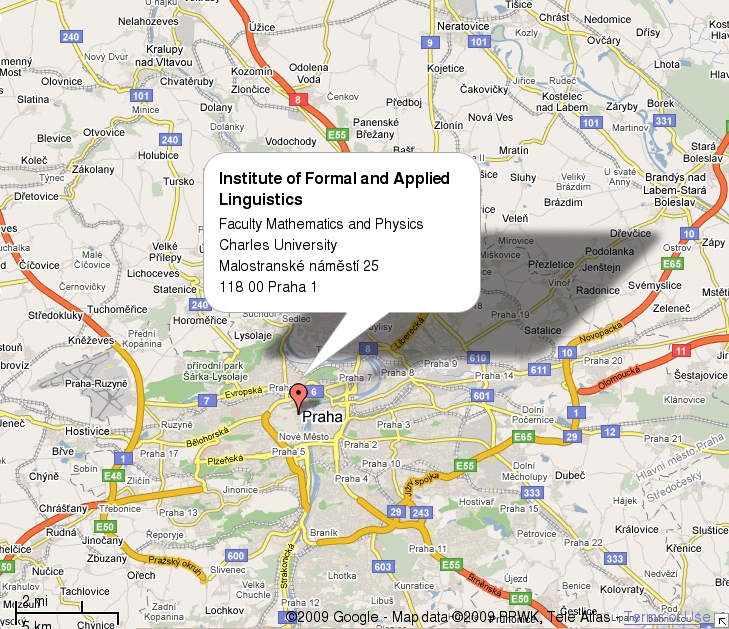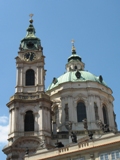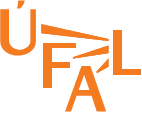Clarin "Centers" Meeting Prague 2009 Venue
The meeting will be held in two places, one on Thursday, Nov. 5 and one on Friday, Nov. 6: on Thursday, the meeting will be held at the representative "Large Mirror Hall" at the Ministry of Education of the Czech Republic, which is the main point of organizing and financing the Czech research infrastructure in all areas of science. On Friday, we will meet at the Computer Science School of the Charles University, where the Institute of Formal and Appplied Linguistics - the main Czech Clarin Center coordinator - is located. Please refer below for the map and addresses of these two venues.
Overall Map of Prague - the venue(s)

Annotated Google Map
Venue Address
Thursday, Nov. 5:
Ministry of Education, Building C
Karmelitska 8
CZ-11000 Praha 1
Czech Republic
Friday, Nov. 6:
Malostranské nám. 25
CZ-11800 Praha 1
Czech Republic
Ministry of Education Building
Three houses originally stood on the site of the contemporary palace, which were structurally connected by architect, builder and stonemason Bonifac Wohlmut around 1571. One of them had a theatre hall in 1700-1713 where German opera performances took place. In the 1790s, these houses became the property of the Cernins of Chudenice, who had them reconstructed and unified in 1796, with the reconstruction being designed by master builder Josef Zobel.
This palace also belonged to Peter Biron, Duke of Courland and Sagan, who was i.a. the owner of Nachod Estate in 1792-1800 and was described by writer Alois Jirasek in his novel Na dvore vevodskem [At the Ducal Court]. After his death, the Prague palace was used by his daughters, thus even Katharina Wilhelmine, Duchess of Sagan - the famous "Madam Duchess" from Bozena Nemcova novel Babicka [Grandmother]. In 1806, the palace was bought from her own family by Princess Marie Luisa Paulina Hohenzollern-Hechingen, the sister of Katharina Wilhelmine. It also later belonged to the Elector of Hesse.
In 1816, the building became the property of Duke Charles Alain Rohan of Bouillon and Montbazon, under whom it acquired, after a reconstruction between 1838 and 1841, its contemporary Late Classicist appearance. It was owned by the Rohans from 1816 to 1945.
With its wings, the two-storey building encloses two courtyards. The parapet gable is decorated with the Rohan coat-of-arms. An interesting and quite rare element is the window with a Syrian arch. On the rear facade, the Ionic pilaster heads have been replaced by Corinthian ones, the character of the windows is the same as in the case of the other faĂdes.
In the ground-floor areas, Early and High Baroque as well as Classicist vaulting has been used. The central wing, dividing the courtyards, is decorated in the corners by niches with vases with lion heads and an attractive bronze nude by the sculptor Bretislav Benda (1897-1985), who was a student of Myslbek and Stursa.
The most interesting room of the palace is The Large Mirror, originally Dance, Hall on the first floor with that so-called Syrian window. The floor's interior is divided by a pair of Corinthian columns on the shorter sides; it has coffered ceilings, and the floors are inlaid in Classicist style.
 The above text (C) Ministry of Education of
the Czech Republic.
The above text (C) Ministry of Education of
the Czech Republic.
Computer Science Faculty Building
The venue of Clarin Meeting in Prague (the Computer Science School building, see the left-hand picture below - on the horizon, the Prague Castle (Hradčany) can be seen as well) is in the center of Prague, in the Lesser Town. The building itself has been built in today's shape in the 17th century, and it served as a jesuit monastery. It has a rectangular shape with a small yard in the middle; three wings now belong to the University, and the fourth to the (roman-catholic) church, and in fact it is the largest baroque church in Prague (the right-hand picture).
 |
 |
Panoramic view from St. Nicolas Church.
Suggested Hotels Nearby
- Hotel Prague Castle ****, U Železné lávky 12, 110 00 Praha 1 (discount available, mention "Clarin")
- Hotel Residence Trinidad ****, U Železné lávky 14, 118 00 Praha 1
- Hotel Biskupský Dům ****, Dražického náměstí 6-9, 118 00 Praha 1
- Hotel Čertovka ****, U Lužického semináře 85/2, 118 00 Praha 1
- Hotel Roma ****, Újezd 24, 110 00 Praha 1
- Hotel U tří pštrosů ****, Dražického náměstí 12, 110 00 Praha 1
- Hotel Kampa Garden ***, U Sovových mlýnů 543/9, 118 00 Praha 1
Other Useful Links
- Annotated Google Map
- Further on-line maps: Mapy.cz, Supermapy.cz
- Public transport, including connection finder.
- Journey planner for trains and buses in the Czech Republic.


